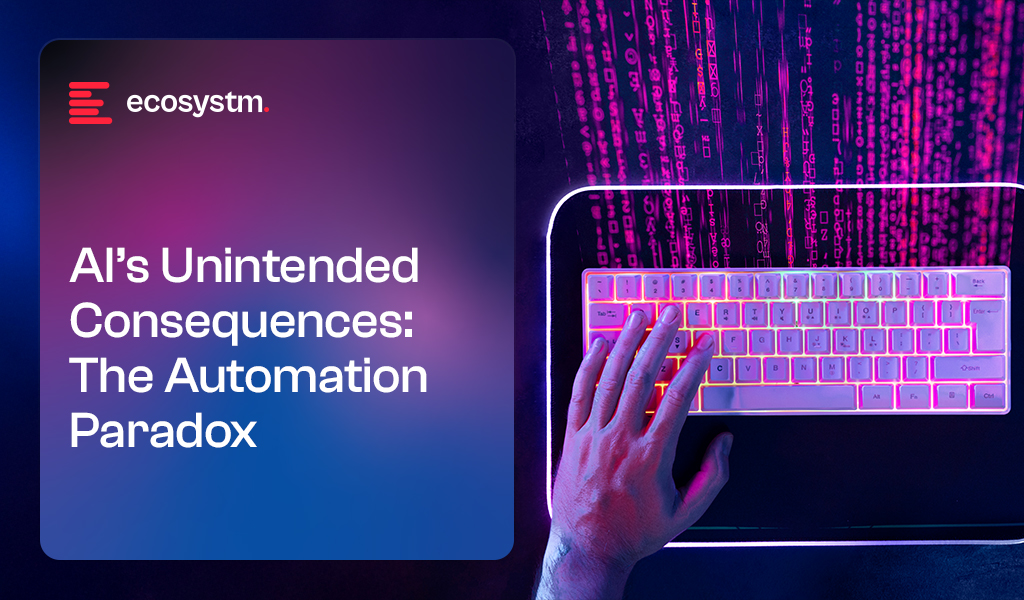Automation and AI hold immense promise for accelerating productivity, reducing errors, and streamlining tasks across virtually every industry. From manufacturing plants that operate robotic arms to software-driven solutions that analyse millions of data points in seconds, these technological advancements are revolutionising how we work. However, AI has already led to, and will continue to bring about, many unintended consequences.
One that has been discussed for nearly a decade but is starting to impact employees and brand experiences is the “automation paradox”. As AI and automation take on more routine tasks, employees find themselves tackling the complex exceptions and making high-stakes decisions.
What is the Automation Paradox?
1. The Shifting Burden from Low to High Value Tasks
When AI systems handle mundane or repetitive tasks, ‘human’ employees can direct their efforts toward higher-value activities. At first glance, this shift seems purely beneficial. AI helps filter out extraneous work, enabling humans to focus on the tasks that require creativity, empathy, or nuanced judgment. However, by design, these remaining tasks often carry greater responsibility. For instance, in a retail environment with automated checkout systems, a human staff member is more likely to deal with complex refund disputes or tense customer interactions. Or in a warehouse, as many processes are automated by AI and robots, humans are left with the oversight of, and responsibility for entire processes. Over time, handling primarily high-pressure situations can become mentally exhausting, contributing to job stress and potential burnout.
2. Increased Reliance on Human Judgment in Edge Cases
AI excels at pattern recognition and data processing at scale, but unusual or unprecedented scenarios can stump even the best-trained models. The human workforce is left to solve these complex, context-dependent challenges. Take self-driving cars as an example. While most day-to-day driving can be safely automated, human oversight is essential for unpredictable events – like sudden weather changes or unexpected road hazards.
Human intervention can be a critical, life-or-death matter, amplifying the pressure and stakes for those still in the loop.
3. The Fallibility Factor of AI
Ironically, as AI becomes more capable, humans may trust it too much. When systems make mistakes, it is the human operator who must detect and rectify them. But the further removed people are from the routine checks and balances – since “the system” seems to handle things so competently – the greater the chance that an error goes unnoticed until it has grown into a major problem. For instance, in the aviation industry, pilots who rely heavily on autopilot systems must remain vigilant for rare but critical emergency scenarios, which can be more taxing due to limited practice in handling manual controls.
Add to These the Known Challenges of AI!
Bias in Data and Algorithms. AI systems learn from historical data, which can carry societal and organisational biases. If left unchecked, these algorithms can perpetuate or even amplify unfairness. For instance, an AI-driven hiring platform trained on past decisions might favour candidates from certain backgrounds, unintentionally excluding qualified applicants from underrepresented groups.
Privacy and Data Security Concerns. The power of AI often comes from massive data collection, whether for predicting consumer trends or personalising user experiences. This accumulation of personal and sensitive information raises complex legal and ethical questions. Leaks, hacks, or improper data sharing can cause reputational damage and legal repercussions.
Skills Gap and Workforce Displacement. While AI can eliminate the need for certain manual tasks, it creates a demand for specialised skills, such as data science, machine learning operations, and AI ethics oversight. If an organisation fails to provide employees with retraining opportunities, it risks exacerbating skill gaps and losing valuable institutional knowledge.
Ethical and Social Implications. AI-driven decision-making can have profound impacts on communities. For example, a predictive policing system might inadvertently target specific neighbourhoods based on historical arrest data. When these systems lack transparency or accountability, public trust erodes, and social unrest can follow.
How Can We Mitigate the Known and Unknown Consequences of AI?
While some of the unintended consequences of AI and automation won’t be known until systems are deployed and processes are in practice, there are some basic hygiene approaches that technology leaders and their organisational peers can take to minimise these impacts.
- Human-Centric Design. Incorporate user feedback into AI system development. Tools should be designed to complement human skills, not overshadow them.
- Comprehensive Training. Provide ongoing education for employees expected to handle advanced AI or edge-case scenarios, ensuring they remain engaged and confident when high-stakes decisions arise.
- Robust Governance. Develop clear policies and frameworks that address bias, privacy, and security. Assign accountability to leaders who understand both technology and organisational ethics.
- Transparent Communication. Maintain clear channels of communication regarding what AI can and cannot do. Openness fosters trust, both internally and externally.
- Increase your organisational AIQ (AI Quotient). Most employees are not fully aware of the potential of AI and its opportunity to improve – or change – their roles. Conduct regular upskilling and knowledge sharing activities to improve the AIQ of your employees so they start to understand how people, plus data and technology, will drive their organisation forward.
Let me know your thoughts on the Automation Paradox, and stay tuned for my next blog on redefining employee skill pathways to tackle its challenges.



